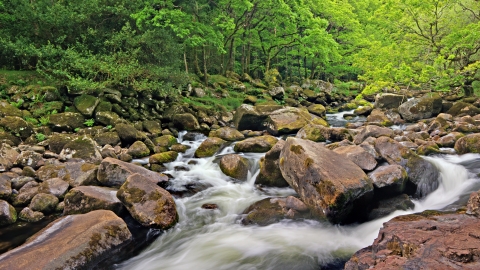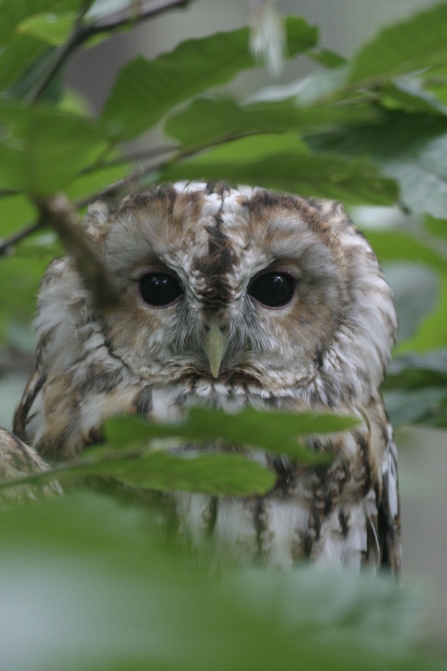
Dart Valley. Photo, David Chamberlain
Please note that this nature reserve has difficult and varied terrain in places, and very limited mobile reception.
Location
Know before you go
Dogs
When to visit
Opening times
Open at all timesBest time to visit
All year roundAbout the reserve
Devon doesn't get much wilder than at Dart Valley nature reserve.
Here the River Dart tumbles through a series of white water twists and turns, between steep-sided, oak covered valley sides. After heavy rain the power of the water can be fearsome.
Devon Wildlife Trust is privileged to manage temperate rainforests in the Dart Valley. These sessile oak woodlands are found within a diverse range of open habitats and wood pastures which support critically endangered species – it is this diversity within the landscape that makes them so special and unique. The Dart Valley is a stunning example of temperate rainforest that we’ll strive to ensure has a bright future, extending in area and connecting with other special sites nearby.
Ash dieback
The disease ash dieback is now widespread in the UK and is present at many of our nature reserves, so we carry out tree felling across our sites in winter months. For your own safety please observe temporary path diversions and closures.
Where possible we will leave affected ash trees in place to decay naturally as an important habitat for wildlife. We plan to only fell diseased ash trees which pose a threat to people or infrastructure. Before trees are felled, we will check whether any rare or protected wildlife is present. If it is, we will postpone or avoid felling these trees. No felling will take place during the bird nesting season.
DWT’s Saving Devon’s Treescapes project are working with communities, landowners and businesses to help make Devon's precious treescapes more resilient in the face of ash dieback. Find out how you can get involved here.
NOTICE: If you are visiting our reserves, please note that there have been instances of H5N1 Avian bird flu found in birds in Devon. There is very low risk to public health, but we do ask that if you come across any unusual or unexplained bird deaths on or near our reserves, please do not touch them and avoid allowing your dog to come into contact with dead birds. Please report them to Defra here or call 03459 335577 and also report your findings to DWT by email at contactus@devonwildlifetrust.org.
Habitat
Contact us
Environmental designation
Location map
How to get to Dart Valley
Beautiful demoiselle in the Dart Valley. Photo, Kevin New.
Your work will be rewarded
Paths through the reserve are narrow and require clambering over moss-covered boulders and lichen-encrusted tree trunks. Walking the full length from end to end will take more than half a day, but the rewards are great.
Beautiful demoiselles and silver-washed fritillaries dance near the water's edge, while dippers search for food in amongst the rapids. Kingfishers are also often seen, while signs of otters can be found at regular intervals on the banks and boulders.

Tawny owl
Night time sounds and sights
At dusk, to a backdrop of the calls of tawny owls, this is a great place to spot bats foraging. Both lesser- and greater-horseshoe bats rely on the woodland's edges as important feeding places.
Climbing out of the valley above the New Bridge entrance and you'll find another side to the reserve. Leaving the rush of the river behind and you'll walk through bracken and pony grazed patches of moorland. These are the places to see yellowhammers and butterflies including the rare high brown fritillary.
You can combine a visit to Dart Valley with an exploration of our nearby Blackadon nature reserve.
This nature reserve is owned by the Spitchwick Manor Estate and managed by Devon Wildlife Trust.
Dart Valley's wildlife is special. We ask that visitors keep disturbance to a minimum by not lighting fires/BBQs and keeping noise-levels down.
Devon Wildlife Trust's Dart Valley nature reserve has been supported by Viridor Credits Environmental Company and Biffa Award.
Safety at the Dart Valley
Dart Valley nature reserve is one of our wilder and more remote sites. Paths into its interior are unmarked and contain challenging sections with steep climbs and unguarded drops. Care needs to be taken at all times of year.
The River Dart is fast-flowing as it passes through the nature reserve and it contains obstructions including boulders and tree trunks. Caution needs to be exercised in and around the river.
Dart Valley nature reserve leaflet
We've got four other wonderful Dartmoor nature reserves for you to explore.
Become a member and support our work
The vital work we do for nature depends on the support of people who care about the future of Devon’s wildlife and wild places.


